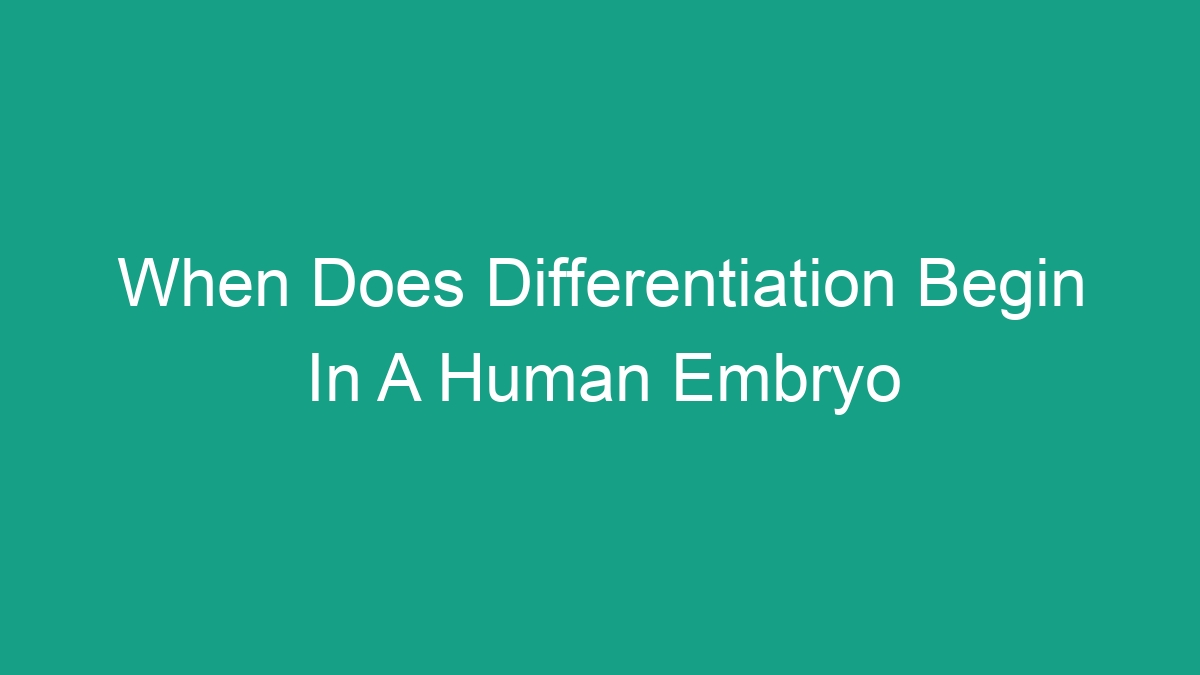
Human embryonic development is a complex and fascinating process that involves a series of cell divisions, molecular signals, and morphological changes. One of the key aspects of this process is differentiation, which refers to the process by which cells become specialized and take on specific functions within the body. Understanding when differentiation begins in a human embryo is crucial for gaining insights into the early stages of human development.
Contents
Early Embryonic Development
Embryonic development in humans begins at fertilization, when a sperm fertilizes an egg to form a zygote. The zygote then undergoes a series of cell divisions, resulting in the formation of a solid ball of cells known as a morula. This morula then undergoes further cell divisions and rearrangements to form a blastocyst, which is a hollow structure made up of an outer layer of cells called the trophoblast and an inner cell mass.
Embryonic Stem Cells and Early Differentiation
The inner cell mass of the blastocyst contains cells known as embryonic stem cells, which have the remarkable ability to differentiate into any type of cell in the human body. This process of differentiation begins very early in embryonic development, as the cells of the inner cell mass start to receive signals from their environment that instruct them to take on specific fates.
At this early stage, the process of differentiation is driven by a combination of genetic programming and signals from the surrounding cells. As the embryo continues to develop, the embryonic stem cells give rise to the three primary germ layers – the ectoderm, the mesoderm, and the endoderm. Each of these germ layers has the potential to give rise to a wide range of cell types and tissues in the human body.
Gastrulation and Germ Layer Formation
One of the key events in early embryonic development is a process called gastrulation, which occurs shortly after the formation of the blastocyst. During gastrulation, the blastocyst undergoes extensive rearrangements and cell movements that result in the formation of the three germ layers.
The ectoderm gives rise to structures such as the skin, nervous system, and sensory organs. The mesoderm gives rise to structures such as muscles, bones, and the circulatory system. The endoderm gives rise to structures such as the digestive system, respiratory system, and endocrine glands.
Cell Differentiation Within Germ Layers
Once the germ layers have been established, the process of differentiation continues within each layer as cells take on more specialized roles. This is a highly regulated process that involves a combination of genetic, molecular, and environmental factors.
For example, within the ectoderm, some cells become neural crest cells that have the potential to give rise to a wide range of cell types, including neurons, glial cells, and melanocytes. Within the mesoderm, some cells become mesenchymal stem cells that have the potential to give rise to bone, cartilage, and connective tissue. Within the endoderm, some cells become precursors to pancreatic cells that eventually give rise to the pancreas and its associated cell types.
Signaling Pathways and Transcription Factors
The process of differentiation within the germ layers is intricately controlled by a variety of signaling pathways and transcription factors. Signaling pathways involve the transmission of molecular signals from one cell to another, often through the binding of ligands to cell surface receptors. These signals can instruct cells to take on specific fates and can also influence their behavior and interactions with other cells.
Transcription factors are proteins that bind to specific regions of DNA and regulate the expression of genes. Differentiation within the embryo is highly dependent on the precise regulation of gene expression, and transcription factors play a key role in this process.
Conclusion
The process of differentiation begins very early in human embryonic development and is a fundamental aspect of the formation of specialized cell types and tissues within the body. Understanding the mechanisms that drive differentiation is crucial for gaining insights into the early stages of human development and for potential applications in regenerative medicine and tissue engineering.
FAQs
Q: What signals drive the process of differentiation in the human embryo?
A: The process of differentiation is driven by a combination of genetic programming and signals from the surrounding cells. These signals can come in the form of molecular signals and physical interactions with neighboring cells.
Q: Can embryonic stem cells differentiate into any type of cell?
A: Yes, embryonic stem cells have the ability to differentiate into any type of cell in the human body. This remarkable potential makes them a valuable resource for research and potential medical applications.
Q: What role do transcription factors play in the process of differentiation?
A: Transcription factors are crucial for the regulation of gene expression during differentiation. They help to orchestrate the activation and repression of specific genes that are necessary for the formation of specialized cell types and tissues.




